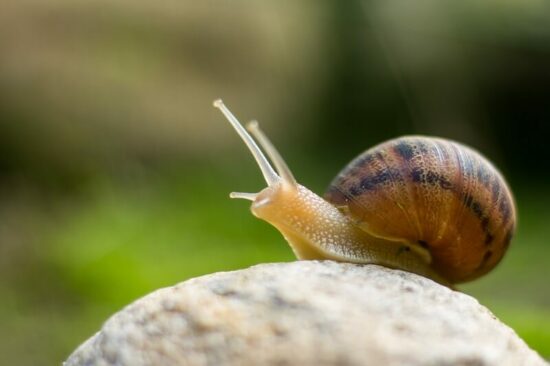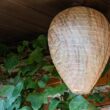If you want to understand why there are snails and slugs on your house, you need to learn about the basic needs of these creatures.
This guide will help you understand the behavior of these animals, so you can stop them from climbing up your house.
Why Are There Snails On My House?
When most people think of snails, they picture them hanging out in the garden under the protection of massive plant leaves. These gastropods can wreak havoc on plants, so gardeners often pluck them off and relocate them. But that usually means placing them far away from your home in a much safer place.
So why are there snails on your house? Here are a few reasons you might see these slimy creatures crawling up your siding or hanging out on windows.
1. There’s Moisture
Here is one of the most common reasons you’ll see snails crawling on your house. Like any other living being, snails need hydration to stay alive (slugs too). Dehydration is a significant issue that snails need to avoid at all costs.
Without moisture in their system, they can’t produce the mucus they need to get around. So how does that relate to your home?
Several potential water sources could attract snails. Rooms with a constant water supply are naturally appealing. For example, you might see snails crawling on the exterior wall or window outside a bathroom or kitchen.
Another possible source is your outdoor water faucet. If you have a spigot coming out of your house, it’s the perfect spot for snails. Those faucets often drip, and the area around them is a haven for these moisture-loving creatures.
Of course, you can also have leaks and other unknown areas of water accumulation. While your home’s siding does a lot to protect it from water damage, issues can cause water to pool beneath it.
Those are all common water sources that snails could seek. But when you see snails crawling on your house, it’s likely due to the humidity. Think about the weather in the last few days. Did it rain?
If so, there’s likely tons of available moisture in the air. If you live near bodies of water, the air could be naturally humid every morning. In that case, seeing snails crawl on your house could be a regular thing!
As the sun raises the temperature and climbs over the horizon, the moist and humid air will rise. Snails follow it and use your home to get as high up as possible to stay hydrated.
2. You Have A Garden Or Vegetables
As mentioned earlier, snails are common garden inhabitants. They love to feed on new tender growth. They can be the bane of gardeners thanks to their penchant for harming or killing young plants.
But it’s not just the greenery they eat. These creatures love to chow down on leaves, but they’ll also eat many popular garden vegetables. They prefer leafy green vegetables like lettuce, kale, and spinach. The slimy pests can also feed on your cucumbers, zucchini, and more.
If you have a garden close to your home, don’t be surprised if you see snails on your house. Snails will often use plants to move around. They leave behind a trail of slimy mucus as they slither their way from one plant leaf to the next.
When you have a garden bed or potted plants touching the exterior of your house, they can easily find a route to your domain.
Expert Tip: This issue is especially common for homeowners with windowsill planter boxes. While that easy access to herbs and vegetables is convenient, it often draws in snails.
3. It’s Safe
Believe it or not, snails also crawl up your house for protection.
Snails are some of the most vulnerable garden pests you’ll encounter. While some species can be significantly bigger than insects, these creatures don’t have much in the way of defense.
The only thing they have is that tough shell. But what happens when it gets crushed? The shell could experience damage from an accidental fall or someone stepping on it.
When that happens, the snail will do what it can to repair it. However, significant damage can cause quick dehydration. They need those shells to stay moist and continue producing that all-important mucus!
Needless to say, protecting themselves and their shells is paramount. When things are dangerous on the ground or in the garden, they might climb on your house for safety. Climbing up a vertical wall is a much safer alternative to being crushed.
But that’s not all.
Snails also have many would-be predators. On the ground, they can fall prey to beetles, salamanders, toads, turtles, and other seemingly innocent creatures. Many larger mammals feast on snails, too. Some examples include rats, squirrels, and raccoons.
Even your dog or cat could be a problem! Larger snail species have to look out for foxes, boars, and other snails.
Typically, snails will use plants as cover. They hide under large leaves and stay out of sight in dense brush. If your property isn’t providing the coverage they need to feel safe, many snails will climb walls to get away from the threat of predators.
While some of the aforementioned predators can scale walls, snails are much safer high up than on the ground. Sure, birds can still pick off the gastropods, and many will not hesitate to swoop right in.
However, the vertical surface they climb is relatively safe. It makes them tougher to spot by scouting birds above. There’s still a risk, but it’s a calculated risk snails are willing to take to stay safe.
4. They’re Looking For Food
As mentioned earlier, snails feed on a wide variety of plant-based foods. While many species stick to gardens, others will resort to your home for a different kind of snack!
When the food on the ground is scarce, snails often scale walls. What do they expect to find up there? Most look for algae and mold!
Algae blooms develop pretty quickly on homes. If you live in a particularly humid part of the country, it can be a real hassle scraping and pressure-washing your siding every few months! The stuff spreads from the ground to your home.
Meanwhile, the light exposure from the rising sun helps algae flourish!
Mold and algae are perfect for hungry snails. They use a radula organ to scrape away algae and other growths. It’s a fantastic food source with plenty of nutritional value for these pests.
Some snail species will crawl up houses to look for other unusual food sources. The gastropods can search for tiny insects, bird droppings, woodlice, etc. If you have anything hanging off your home, such as a box planter or hanging plant basket, they could move towards those objects to feed on nearby food sources.
Expert Tip: Interestingly enough, some snails might eat the siding itself. Giant African land snails are notorious for eating stucco and concrete when they don’t have enough calcium in their systems from other sources. Those snails aren’t exclusive to Africa, so they could appear on your home if you live in a humid state like Florida.
5. They Want To Cool Off
Did you know that snails will move up and down house walls to regulate their temperature? It’s a quirky behavior that makes sense. However, most people don’t realize it’s an action these creatures take.
Earlier, we talked about how many snails will climb on your house to get some moisture from humid air. They will move up the house as the sun comes up to evaporate water. Humid air rises, making a move upward necessary.
Depending on the conditions, they might move closer to the ground to cool off and escape rising hot air.
But if you live in a windier location, the verticality comes in handy. The snails will crawl up your siding to get away from the heat on the ground.
Some snails go through a hibernation-like process called estivation. Estivation typically occurs during long dry summers. When the snail is ready, they’ll crawl up vertical surfaces like your home and find a cool spot.
Then, they use mucus to seal their shells! They create a mucus plug to keep all the moisture inside the shell. Then, the snail retreats deep into the shell and uses a small air pocket as insulation from the heat.
The estivation process is a much-needed period of rest for the snail. The creatures can rest for as little as a few days to several months. Either way, they’ll emerge rejuvenated and ready to go back to the heat.
6. It’s Shady
In some cases, snails will crawl on houses because of the shade your building offers. Pay close attention to where you see the snails. Is it on a south-facing wall with tons of sun exposure, or is it a wall in a perpetual state of shade due to its position or a nearby tree?
If it’s the latter, shade is what these snails are after.
Snails are nocturnal creatures. While some might be active during the day for survival, most prefer to rest during the daylight hours. They’ll find a cozy spot away from the light to power down and relax.
Once the sun dips below the horizon, the snails will emerge to feed.
Shade spots are essential to a snail’s survival. If parts of your home’s exterior offer that, snails will use it to their advantage.
Even if you don’t have an entire wall covered in the shade, there could be small spots of shelter that are discrete enough to keep snails safe as they rest.
For example, take planter boxes. The area underneath is the perfect hiding spot. It’s dark, cool, and out of sight. Best of all, the snail has easy access to possible food and water sources if the planter box houses a thriving plant!
How Do Slugs Get In Your House?
First things first, let’s talk about the difference between a snail and a slug. Both creatures are soft-bodied animals that belong to the mollusk family. The only difference is that one has a shell and the other doesn’t!
Snails and slugs prefer many of the same things and act similarly in garden situations. They also produce that slick mucus trail as they move around. There’s a good chance you could see slugs in the same places you might encounter snails. That includes the side of your house!
So, how do snails and slugs get inside?
In most cases, they squeeze their way through small gaps and cracks. Of course, their success in breaking in depends entirely on the snail species and size.
Larger snails with tough shells can’t squeeze their way under window or door gaps. They could certainly try, but they run the risk of breaking their protective bodies and dying.
Here’s where slugs have the advantage. Slugs don’t have that cumbersome shell in the way, so many will slither through even the smallest air gap!
Small snail species and babies can use tiny voids as well.
Any area with a draft is a potential entry point. That means small gaps around windows and door frames are fair game. The creatures can also use cracks formed by a settling foundation or stressed joist. Snails and slugs can also try to enter through leak spots or poorly sealed openings around wires or pipes.
Conclusion
Snails and slugs on your house isn’t anything to be worried about, but we can appreciate why some people don’t want them. By teaching you why this happens, this guide will make it easier for you to reclaim the side of your house (or the inside) from these pests.
If you have any questions about the information above, let us know!


